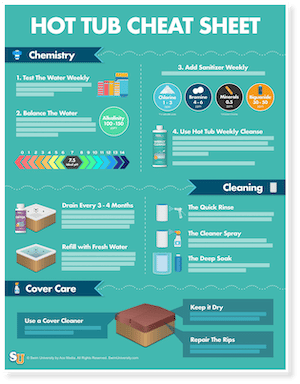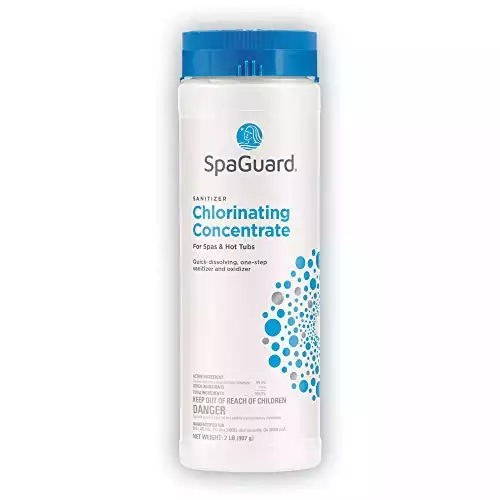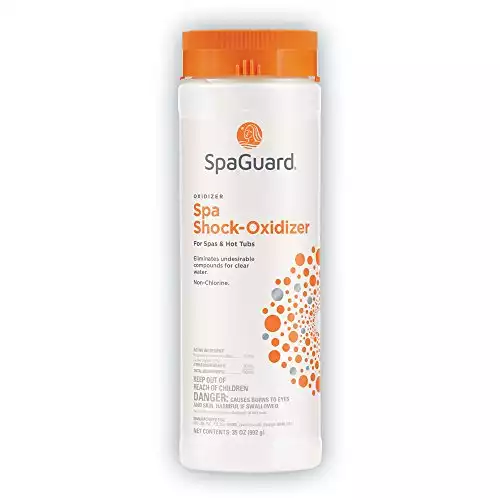Unlike swimming pools, spas have a low volume of water kept at high temperatures. This amplifies the effect of all the contaminants introduced by bathers and by nature, such as sunscreen and leaves. Without proper care, your spa can become a horrifying stew of bacteria and debris that won’t just leave you with cloudy spa water, but may actually make you sick, manifesting in upper respiratory difficulties and ugly rashes.
Now you’ve got a sufficiently motivating mental image, it’s time to troubleshoot the possible causes for your cloudy hot tub. Fix the problem, then find out how to keep it from happening again because no one wants to kick back and relax with a cold one in a tub full of rash-inducing bacteria stew.
What Causes Cloudy Spa Water?
The average home spa holds just 400 gallons of water. You’ll usually keep your hot tub water somewhere in the ideal range of 98°F to 102°F (36°C to 38°C).
This low volume of hot water can be the perfect breeding ground for dangerous bacteria such as Legionella—the cause of Legionnaire’s Disease—if you don’t maintain proper water chemistry. But bacteria growth is just one of several things that can cause cloudy spa water.
Algae and Helicopters Landing in Your Hot Tub
No, the local traffic report isn’t being conducted in your hot tub. We’re referring to the tree seed pods commonly known as helicopters. Also dead leaves, grass clippings, and all the other natural matter that blows around your backyard can land in your hot tub during use or when left uncovered.
As your sanitizer tries to break down the invaders, however large or small, it’s quickly used up. This means the chlorine (or bromine, or whatever sanitizer you’re using) may not be able to keep up with killing bacteria and other contaminants because it’s trying to destroy whirligigs instead.
Easy to add chlorine to your hot tub with granules (powder) and a cap that's perfect for measuring the amounts you add.
Allowing nature to invade your spa can also clog up your circulation system and filter, preventing it from working effectively. As the debris deteriorates, you wind up with cloudy spa water.
Another living water contaminant is algae. The main cause of algae growth in spas is poor water chemistry. Both algae itself and lackadaisical water maintenance can make your water cloudy.
Finally, if you use shock, the dead algae floating around in your water and circulation system may cause gross-looking water until you get all the little algae skeletons out of there. OK, algae doesn’t really have skeletons. But you get our meaning.
Metal in Your Water Isn’t Shiny—It’s Cloudy
When you fill your hot tub, you probably hook a hose up to an outdoor spigot or indoor tap and let it run until your spa is full. Do you know whether your household water source has high concentrations of metal?
Metals in water don’t usually cause any major problems with things like laundry or cooking, but they can wreak havoc on your hot tub. Over the long term, filling your spa with water that contains metal can alter your water chemistry, and can stain your spa’s shell and components.
If you’re not using a hose filter when you fill your hot tub, metal contaminants in your hard water could be contributing to cloudiness.
Fill your pool or hot tub with this hose filter that'll filter your water so you can have a fresh start with water chemistry.
Low Sanitizer With a High Chance of Cloudiness
Has your spa recently had a high bather load? If you’ve had more guests using your spa than usual, you may not be adding enough sanitizer to keep up with the amount of foreign matter (read: body oils, shampoo residue, and other icky stuff humans slough off everywhere they go) being introduced to the water.
When you notice cloudiness after an increase in hot tub use, insufficient sanitizer levels might be the culprit. When you don’t have enough chlorine or bromine to effectively sanitize your spa water, bacteria, algae, sunscreen, and even—yes, we’re sorry to say—fecal matter is able to linger in the water causing a cloudy appearance. Your fellow bathers could even pass illnesses to each other and you.
Poor Water Chemistry
Like most things in life, achieving balanced hot tub chemistry isn’t impossible, but maintaining balanced water all the time takes work and dedication.
If you’ve let your water care routine slip, your cloudy spa water could be the result. Not all chemistry problems necessarily cause cloudiness, though. So what should you look for?
- High pH: Your spa water is too basic if the pH is higher than 7.6. When this happens, you’ll wind up with two problems that cause cloudiness: scale formation and ineffective sanitizing. You may need to use a pH decreaser to get things back to normal.
- High alkalinity: Another way to say water is basic is to call it alkaline. When your hot tub water has alkalinity higher than 150 ppm, it begins to form scale. It also cannot keep pH stable, compounding all the issues that may cause cloudy water. An alkalinity decreaser may help.
- High calcium hardness: Ideally, your spa’s calcium hardness will be between 175 to 250 ppm. If your levels are too high, you’ll see scale build up and cloudiness.
Humans: The Worst Offenders
Of course you want other people to enjoy your hot tub, but wouldn’t it be nice if they didn’t bring contaminants with them? Let’s face it: humans are kinda gross. Just a short list of residual yuckiness your friends may leave to cloud your hot tub water includes: makeup, lotion, sunscreen, hair products, sweat, body oil, and the two you don’t even want to think about, urine residue and fecal matter. Hey, it’s not pleasant for us to talk about it either, but you need to know what you’re up against.
Even if every person who uses your hot tub takes a shower before getting in, you’ll still wind up with some human-introduced contaminants. And if your sanitizer or filtration system can’t keep up for any reason, you’ll wind up with cloudy hot tub water. And maybe a little paranoia about what’s actually floating in your spa water.
This chlorine shock helps reduce bacteria growth of bacteria and treat algae problems in your hot tub. It's best used in chlorine or salt water spas.
Biofilm: Not the Kind of Film You Want to See
This slimy, sticky film can cover your hot tub surfaces and set up camp in your spa’s plumbing. For comparison, the plaque that forms on your teeth between cleanings from your dentist is a form of biofilm, and we know how that can end if not treated.
Just like plaque can lead to cavities, biofilm is bacteria residue that can propagate and eat away at your hot tub’s surfaces, becoming a major problem if it’s not addressed. Not only will it make your water look gross, it also allows dangerous bacteria to proliferate, such as Legionella and E. coli. The problem is, the film the bacteria coats itself with protects it from disinfectants, so your sanitizer isn’t enough to combat it.
Tired of trying to keep your hot tub clean all the time and dealing with chemicals?
You'll save $100 right away with this easy-to-follow digital ebook and video course. This is the ultimate maintenance guide that hot tub manufacturer doesn’t provide you.
Click Here to Learn MoreFilter Problems
A slightly more obvious potential cause of your cloudy spa is a dirty or misaligned filter. Dirty water is sucked into your filtration system so the filter can get rid of larger particles your sanitizing chemicals would take too long to break down.
But if your filter is gunked up or not properly seated, those particles wind up suspended in your spa water, slowly decomposing, leaving your water cloudy and dirty.
Clear That Cloudy Hot Tub
Once you’ve established the cause of your cloudy spa water, you’ll need to address it immediately to avoid damage to your spa, such as staining and scale buildup, or worse.
While you could pour in a little clarifier if you’re in a time crunch, that only fixes the symptom, not the cause of the cloudiness. The problem will return if you don’t take steps to eradicate the source of it.
Clean The Filter
At the first sign of cloudy spa water, check your filter. Pull it out, give it a deep cleaning or replace it Whether it’s gunked up with sunscreen, choked by flakes of scale, or full of algae, if your filter can’t do its job well, it will show up in your water.
Run The Filter
Your spa water needs to go through filtration for at least one hour, twice a day. Whether you run it manually or program automatic filter cycles, be sure you’re doing so often enough to clear contaminants so your sanitizer can work.
Remember, more hot tub use requires more filtering and more sanitizer.
Get Those Chemical Levels Just Right
If you determined a specific chemical needs to be adjusted in your spa due to cloudy hot tub water, fix that first. Once you’ve done that, test your water to make sure all your chemical levels are still where they need to be. If they’re not, adjust accordingly.
To make troubleshooting chemical levels even easier, make—and stick to—a hot tub maintenance schedule that includes water care.
Tests for 7 important chemistries in seconds: Total Hardness, Total Chlorine, Total Bromine, Free Chlorine, pH, Total Alkalinity, and Cyanuric Acid.
Give it a Good Shock
Algae blooms and all sorts of contaminants can be stopped in their tracks with a good, ol’ shock. In fact, when you follow recommended water care for your hot tub, you’ll be adding spa shock weekly (or even more often) depending on the capacity of your hot tub and how much use it gets.
Metal Sequestrant
Unlike the other solutions, which are part of maintaining an overall healthy spa, you won’t need to add a sequestrant unless you’ve determined that your water source contains metals, and that they’re the cause of your cloudy hot tub water.
If metal is indeed the culprit, you can add a metal sequestrant which will bind with the metal, preventing it from oxidizing and discoloring your spa and water. You’ll need to add it when refill your hot tub (using filtered water), as well as adding a weekly maintenance dose.
Flush the Circulation System
To address a biofilm problem, and just as a general best practice, flush your spa lines whenever you change your water. Before draining your hot tub, add a line flush product to your cloudy spa water. Allow it to circulate for at least 30 minutes, but check the product you choose for the recommended circulation time just to be sure.
You’ll most likely see some foaming while the flush circulates. This is normal. It’s just all the biofilm and other gunk coming out of the plumbing. This is why you use line flush before you drain the hot tub. Otherwise, you’ll be draining and refilling twice.
Don't let your hot tub fill with hard-to-remove gunk. Clear out the gunk and keep your hot tub water fresh. It removes gunk in your pipes caused by lotions, sunscreens, cosmetics, etc.
Kills bacteria inside the pipes for maximum effect.
Drain and Refill Your Hot Tub
You change your hot tub water every three months or so anyway, right? (Please say yes. If you’re not already doing that, start now.) But if you’re experiencing cloudiness that just won’t go away despite your best efforts, it’s time to break out the big guns and drain and clean your hot tub.
Start with a line flush product and a new filter, drain your spa, thoroughly clean the shell, then fill it up using a hose filter.
Remember to add a metal sequestrant if necessary, then shock and balance the fresh water, so you’re starting up with with a clean slate.
Keep a Cloudy Hot Tub from Coming Back
What’s the best way to fix cloudy spa water? Keep it from happening in the first place! You fill your hot tub up with clear water, not cloudy. Keeping it that way is much easier than trying to get it back from that body oil stew condition. Ew.
Follow some simple best practices to keep cloudy spa water at bay.
- Fill your clean hot tub with filtered water. This is super easy to do with a hose filter.
- Create and follow a regular maintenance schedule to keep your water chemistry balanced, and everything clean and sanitary.
- Keep your filter clean, and replace it as needed.
- Maintain an appropriate level of sanitizer, being sure to take bather load into account.
- Use a line flush product with every water change to clear your spa’s plumbing and keep biofilm in check.
- Test your water before adding chemicals. Then test it after adding chemicals. And then test it one more time before you get into the water. Always be testing!
- Change water every three to four months, and more often if problems arise.
Keep it always feeling like new between Detoxes with our one-time-a-week treatment that combines hot tub cleaner, conditioner, and clarifier to give your hot tub water a soft & silky feel plus sparkling clean water!
The Work is Worth the Clear Water
You know what they say: “An ounce of prevention is worth a pound of cure.” Or in this particular case, about 400 gallons of fresh water and a whole bunch of chemicals.
Don’t let all that go to waste. Keep up with your maintenance, and that cloudy spa water will become but a distant memory.
Happy Soaking!

Recommended Guides
You’ve cleaned. You’ve scrubbed. And still, you have hot tub stains. Why? How do you remove them? And keep them from coming back? It’s all about the water.
Did you find foam in your hot tub? That's no place for a bubble bath. Don't worry. It's easy to get rid of hot tub foam, and even easier to prevent it.
Do you have white flakes in your hot tub? Learn what they are, their causes, and how to get rid of them, and how to keep them from coming back.
What’s that buildup in your spa shell? Oh, it’s just hot tub scale. It’s not harmful, but the longer you leave it, the bigger the problem you may have.













